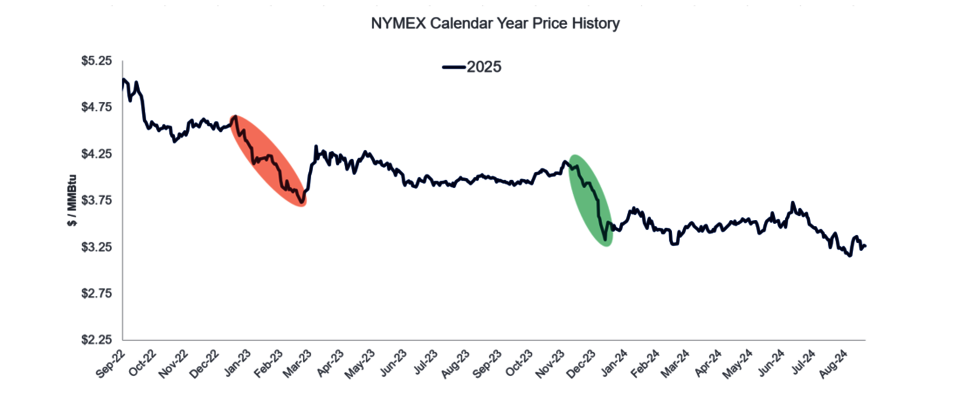Short-term memory can cause long-term pain

By Jeff Bolyard, Principal, Energy Supply Advisory
This post is featured in our August 2024 Monthly Monitor, which includes articles and analysis for the natural gas, electric, crude oil, and sustainability markets. To read the full report and sign up for the Monthly Monitor distribution list, click here.
Last week, buried in the detail of the weekly natural gas storage report from the Energy Information Administration (EIA), numbers indicated that underground storage was 209 Bcf ahead of last year and 375 Bcf ahead of the 5-year average. The status of storage has long been a seasonal bellwether of natural gas prices. The higher the storage surplus, the lower the price in the forwards – and this is where we are today. The prompt month NYMEX September 2024 futures contract closed on 8/26/2024 at a price of $1.95 per MMBtu. Assuming that price holds for another week, it would be a 26-year low for September.
Looking further into 2025, prices are not quite as attractive when compared to September by itself. For the same close date of 8/26, the calendar year 2025 NYMEX average was $3.23/MMBtu, roughly $1.25 higher than the price for next month (September). But before we scrap any hedge strategy for 2025 to wait for prices to fall in line with near-term prices, let’s take a look at where we’ve been with calendar year 2025 NYMEX pricing.
Below is a chart that shows the NYMEX calendar year 2025 historical pricing. On the far-right side is where we are today at $3.23/MMBtu. Two years ago, the same Cal 2025 strip was $1.59 higher and could have been purchased at $4.82 (far left on chart).
We can easily see that the price trend has gone down, but what isn’t as easy is remembering what happened over that two-year span to cause the significant drop in 2025 pricing that we now see.

The orange-shaded oval on the left of the chart highlights a $0.58 drop in 2025 prices over a stretch of just 49 days between 1/3/23 and 2/21/23. Many would consider this a monumental drop for a calendar year strip price that was, at the time, nearly two years away from starting. The second highlight is the green shaded oval, highlighting a second drop of $0.70/MMBtu, which occurred between 11/15/2023 and 12/26/2023. This was also a significant decrease for a forward calendar year strip that was still over a year from starting.
Driving each of these drops was the year-over-year storage surplus compared to the same weeks in 2022, which began and ended the year with extraordinarily low storage levels. This is unlikely to occur this year since we are already at a surplus in storage and likely already baked into current forward pricing. Contributing to the two highlighted price drops and allowing them to keep the downward trend going was the overriding mover of all natural gas prices: weather. The U.S. has had two consecutive winters of extremely mild winter weather, with the most recent winter of 2023-2024 being the mildest in 129 years (NOAA data).
Balancing a hedge strategy that incorporates the appropriate amount of protection against rising market prices with the right volumes that take advantage of market opportunity is always tricky - a decision that requires careful consideration and varies by company. With storage in great shape, how much risk does one want to take when the current market has already given back over $1.50 per MMBtu for Cal 2025? And how much lower could it go without waiting to see how cold the upcoming winter might be?
Looking at the additional downside potential vs. the upside risk in the past decade, the highest calendar year NYMEX average was $6.64/MMBtu (2022), or $3.41 higher than the current 2025 strip, while the lowest was $2.07/MMBtu (2020) - $1.16/MMBtu lower than the current 2025 price.
If you have a strategy that you’re comfortable with, great! If you’re not comfortable with how much your budget is protected or open to market movement in 2025, don’t let your short-term memory of how the market got here cloud the decision-making process for your natural gas purchasing strategy for next year.
